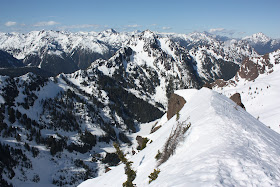 |
| Mount Washington from Mount Ellinor |
Difficulty: Moderate-strenuous
Access: Decent gravel road to trailhead, Northwest Forest Pass required
Mount Ellinor is the southeastern anchor of the Olympic Mountains and thus provides outstanding views of both the interior of the Olympic Mountains and the southern Puget Sound area. Ellinor is a popular hike not only during the summer, but also during the spring: after avalanche danger calms down, a fairly straightforward winter route allows those with sufficient snow hiking equipment and experience to access the summit. The hike packs a pretty substantial elevation gain, but those in good shape will find the summit panorama more than worth it: although not easy, this is still one of the easiest hikes to a craggy summit in the Olympic Mountains.
I've hiked this trail twice, once in early April in a year with below-average snowpack and the second time in late May in a year with above-average snowpack; the conditions were very similar both times. My first visit was on a partly cloudy but mostly beautiful April day, setting out from Seattle with a group of four friends. We took I-5 south to Olympia, then US 101 north from Olympia to Hoodsport. At Hoodsport, just past the IGA, we turned left onto Route 119, or Lake Cushman Road; we followed the at times windy road to a T-intersection. Here, we turned right onto an unpaved road, following the sign towards Mt. Ellinor; after following this road for about two miles, we turned left onto the NF-2419, a gravel road that departed sharply to the left and headed uphill. We followed this road until we came to the lower trailhead for Mount Ellinor, where we parked.
The trail set off from the south side of the road (the left side of the road from the direction of approach), climbing immediately through forest to a ridge. The first mile and a half of the hike consisted of a steady but fairly gentle climb through the forest along the ridge, with some stretches of old growth with fairly large trees. The trail is mostly dirt, not too rocky, and generally pleasant hiking through this section.
 |
| Forest on the lower trail |
 |
| Mount Washington from the lower trail |
About a mile and a half from the trailhead, the lower trail came to a junction with the upper trail, which departs from a higher elevation trailhead. Summer hikers may prefer the upper trailhead to cut out distance and elevation gain; hikers in other seasons will usually find that they must use the lower trailhead due to snow on the road at higher elevations. After joining the upper trail, the combined Mount Ellinor trail switchbacked aggressively up a ridge, then veered north into a small clearing at the foot of an avalanche chute. Here, the summer routes and the winter routes diverged: the summer trail, an established route, tackled the slopes to the northwest, but was completely covered in snow and was impossible to follow in April. We instead followed the winter route, which was simply to ascend up a steep gully towards an alpine bowl between Ellinor and Washington.
The winter route presents numerous dangers, so it's important to have the ability to assess conditions and decide whether or not the route is safe and doable. The main fact to note here is that the winter route ascends an avalanche chute: if there appears to be any chance of an avalanche, it's best to leave the rest of the ascent for another day. If avalanche danger is low, it's important to figure out what gear is best suited to existing snow conditions. We were able to successfully tackle (although not without some struggle) the slope with poles and microspikes. However, icier conditions might have demanded an ice ax and crampons, while substantially softer snow would have required snowshoes. The snow was still fairly soft, so we postholed quite often, but we were able to make slow but steady progress upslope.
As we ascended along the avalanche chute, views started opening up to the south. We could see Lake Cushman and the lower southern peaks of the Olympics; Mount Rainier came in and out of our field of view.
 |
| View towards the lower peaks of the southern Olympics |
 |
| Winter route |
 |
| Mount Rainier viewed from the climb up the winter route |
 |
| Summit of Mount Ellinor |
 |
| View into the Olympics |
 |
| Mount Olympus from the summit of Ellinor |
Ascending the chute up the winter route was a tiring and difficult challenge, but descending was fast and exhilarating. Since the day was fairly warm and sunny, the snow was soft enough for safely glissading in such steep terrain. We took two short glissades to descend from the summit to the top of the chute, then launched ourselves down the glissade chute that had already been carved out in the gully through which we had ascended. In less than two minutes, we had descended one thousand feet, probably exceeding over 10 miles per hour at some points in our slide down.
If you plan to glissade, be sure to monitor conditions when you come up and make sure you have all the necessary equipment to glissade safely. In icier conditions, an ice axe is absolutely essential; later in the season, when the snow is further melted, rocks may make the glissade much more dangerous.
 |
| Lake Cushman and the glissade chute down the winter route |
No comments:
Post a Comment